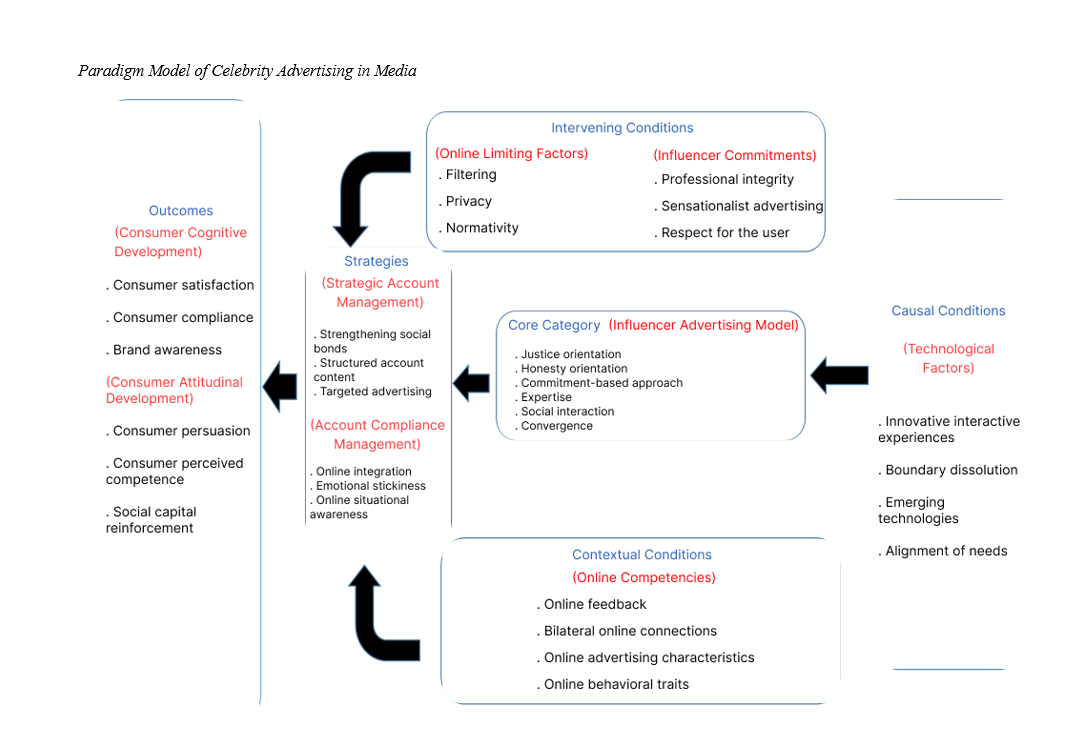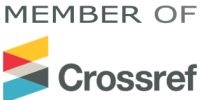Influencer-Based Commercial Advertising and Its Impact on Users’ Purchase Motivation: A Model for Social Media Networks
Keywords:
Social Media, Commercial Advertising, Celebrities, Purchase MotivationAbstract
This study was conducted with the aim of presenting a model for commercial advertising on celebrity accounts on social media platforms and examining their impact on users’ purchase motivation. Adopting a qualitative and exploratory strategy, the research employed the grounded theory method, with data collected through semi-structured in-depth interviews. The qualitative participants included 15 managers, professionals, experts, and researchers in the field of social media advertising in Iraq during 2023–2024, selected using purposive sampling. The findings were analyzed through open, axial, and selective coding, resulting in a model comprising six core axial codes: causal conditions (technological factors including innovative interactive experiences, boundary dissolution, emerging technologies, and alignment of needs), contextual conditions (online competencies such as online feedback, bilateral online connections, features of online advertising, and online behavioral traits), intervening conditions (influencer commitments including professional integrity, sensationalist advertising, and user respect; and online limiting factors such as filtering, privacy, and normativity), strategies (strategic account management involving social bond reinforcement, structured account content, and targeted advertising; along with account compliance management including online integration, online stickiness, and situational awareness), outcomes (consumer cognitive development involving satisfaction, compliance, and brand awareness; and consumer attitude development including persuasion, perceived competence, and social capital reinforcement), and a core category defined as the influencer advertising model, which encompasses justice orientation, honesty orientation, commitment-based approach, expertise, social interaction, and convergence. The findings demonstrate that influencers have emerged as highly influential actors in the business and marketing landscape on social media, and the proposed model may serve as a practical framework for corporate advertising strategies in Iraq, contributing significantly to the nation’s economic development.
References
Ao, L., Bansal, R., Pruthi, N., & Khaskheli, M. B. (2023). Impact of Social Media Influencers on Customer Engagement and Purchase Intention: A Meta-Analysis. Sustainability, 15(3), 2744. https://doi.org/10.3390/su15032744
Baudier, P., de Boissieu, E., & Duchemin, M.-H. (2023). Source Credibility and Emotions generated by Robot and Human Influencers: The perception of luxury brand representatives. Technological Forecasting and Social Change, 187, 122255. https://doi.org/10.1016/j.techfore.2022.122255
Bevan-Dye, A. (2023). Ascertaining the Antecedents of Generation Y Consumers’ Perceived Utility of Celebrity Influencers’ Fashion Content on Instagram and Consequent Fashion Brand Predispositions and Purchase Intentions. Innovative Marketing, 19(4), 81-94. https://doi.org/10.21511/im.19(4).2023.07
Chaturvedi, P. (2025). Scaling Influencer Marketing Operations: Legal and Financial Challenges in Managing Large Scale Influencer Network. Journal of Information Systems Engineering & Management, 10(7s), 542-552. https://doi.org/10.52783/jisem.v10i7s.912
Chen, W.-T., & Hsieh, M. H. (2024). Keep the Influencers! Exploring How Sacrifice Enhances “Creator Self-Identity” and Providing Practical Recommendations by the Marketing Mix: An Exploratory Study. Sage Open, 14(4). https://doi.org/10.1177/21582440241290572
Dunn, S. S., & Nisbett, G. S. (2025). College NIL Athletes as Social Media Influencers: Examining Sports vs Lifestyle Posts on Consumer Perceptions. International Journal of Sports Marketing and Sponsorship. https://doi.org/10.1108/ijsms-08-2024-0194
Erwin, E., Maupa, H., Jilbert, J., & Sanusi, A. (2024). Co-Creation Building Power on Social Media: Can Influencers or Viral Campaigns Do It for Marketing Performance? Revista De Gestão Social E Ambiental, 18(7), e06819. https://doi.org/10.24857/rgsa.v18n7-139
Erwin, E., Suade, Y. K. M., & Alam, N. (2023). Social Media Micro-Enterprise: Utilizing Social Media Influencers, Marketing Contents and Viral Marketing Campaigns to Increase Customer Engagement. 578-593. https://doi.org/10.2991/978-2-38476-064-0_58
Galdón-Salvador, J.-L., Gil-Pechuán, I., AlFraihat, S.-F.-A., & Saeed, M. Z. A. T. (2024). Effect of Social Media Influencers on Consumer Brand Engagement and Its Implications on Business Decision Making. El Profesional De La Información, 33(2). https://doi.org/10.3145/epi.2024.0210
Ghosh, P., Upadhyay, S., Srivastava, V., Dhiman, R., & Yu, L. (2024). How Influencer Characteristics Drive Gen Z Behavioural Intentions of Selecting Fast-Food Restaurants: Mediating Roles of Consumer Emotions and Self-Construal. British Food Journal, 126(12), 4072-4092. https://doi.org/10.1108/bfj-12-2023-1154
Hani, G., Haider, S. W., Raza, A., Silva, S. C. e., & Dias, J. C. (2024). Digital Influencers: Catalysts for Customer Engagement and Purchase Intention. Studia Universitatis Babe-Bolyai Oeconomica, 69(2), 40-61. https://doi.org/10.2478/subboec-2024-0009
Kilipiri, E., Papaioannou, E., & Kotzaivazoglou, I. (2023). Social media and influencer marketing for promoting sustainable tourism destinations: The Instagram case. Sustainability, 15(8), 6374. https://doi.org/10.3390/su15086374
McEnnis, S. (2023). There He Goes: The Influencer–Sports Journalism of Fabrizio Romano on Twitter and Its Implications for Professionalism. Journalism and Media, 4(2), 430-444. https://doi.org/10.3390/journalmedia4020028
Mirghaderi, L. (2022). Social Media Users' Free Labor in Iran: Influencers, Ethical Conduct and Labor Exploitation. Frontiers in Sociology, 7. https://doi.org/10.3389/fsoc.2022.1006146
Mishra, P. P., Chand, P. K., & Kaith, M. K. (2022). Influencer Marketing as Emerging Promotional Tool in Modern Era And Opportunities to Uprising Sales. International Journal of Emerging Research in Engineering Science and Management, 1(3). https://doi.org/10.58482/ijeresm.v1i3.3
Moghaddar, I., Imamgholizadeh, S., & Saheb-Dari, M. (2024). Influencer marketing: Identifying and explaining the psychological impacts of social media influencers on consumers (Case study: Female students of Mazandaran University). Modern Marketing Research, 13(3), 23-48.
Motta, M., Liu, Y., & Yarnell, A. (2023). “Influencing the Influencers:” a Field Experimental Approach to Promoting Effective Mental Health Communication on TikTok. https://doi.org/10.31235/osf.io/amzdb
Mursalin, A., Purbaningsih, Y., Boediman, S. F., Siagawati, M., & Sitaniapessy, R. H. (2023). Understanding Ai-Driven Influencer Marketing. International Journal of Humanities Social Sciences and Business (Injoss), 2(3), 443-455. https://doi.org/10.54443/injoss.v2i3.90
Musa, A. H., Baharuddin, F. N., Antara, P. M., Selamat, S. M., Raja Mayang Delima Mohd, B., & Ali, A. (2024). Viral Marketing and Social Media Influencer Roles in Purchasing Skincare Product: A Conceptual Paper. International Journal of Academic Research in Business and Social Sciences, 14(5). https://doi.org/10.6007/ijarbss/v14-i5/21619
Polat, E., Çelik, F., Ibrahim, B., & Gursoy, D. (2024). Past, present, and future scene of influencer marketing in hospitality and tourism management. Journal of Travel & Tourism Marketing, 41(3), 322-343. https://doi.org/10.1080/10548408.2024.2317741
Qi, Y. (2024). The Road to Branding in the Digital Age: The Power and Challenges of New Media Influencers. Lecture Notes in Education Psychology and Public Media, 50(1), 6-12. https://doi.org/10.54254/2753-7048/50/20240779
R, S. R. (2024). Harnessing Business Analytics for Influencer Marketing. 267-278. https://doi.org/10.4018/979-8-3693-9230-0.ch013
Rachmad, Y. E. (2024). The Future of Influencer Marketing: Evolution of Consumer Behavior in the Digital World. PT. Sonpedia Publishing Indonesia. https://buku.sonpedia.com/2024/06/the-future-of-influencer-marketing.html
Rambocas, M., & Metivier, J. (2024). How Does the Influencers' Country of Origin Affect Online Brand Advocacy Among Young Consumers? Young Consumers Insight and Ideas for Responsible Marketers, 25(6), 909-927. https://doi.org/10.1108/yc-01-2024-1970
Saidi, S. B., Akhavanfar, F., & Fattahi, M. (2022). Presenting a marketing model through influencers (influencer marketing) in the purchase and consumption of domestic products with a grounded theory approach. Consumer Behavior Studies, 9(1), 113-133.
Xin, B., Hao, Y., & Xie, L. (2024). Virtual Influencers and Corporate Reputation: From Marketing Game to Empirical Analysis. Journal of Research in Interactive Marketing, 18(5), 759-786. https://doi.org/10.1108/jrim-10-2023-0330
Xu, M. M., Scherer, E., Robbins, R., Liu, Y., Motta, M., & Yarnell, A. (2024). ‘Influencing the Influencers’: Exploring the Impact of an in-Person Summit on TikTokers’ Mental Health Communication Habits and Beliefs. https://doi.org/10.31235/osf.io/v83ht
Yu, J., & Zhang, Y. (2023). The impact of influencer marketing on customer brand engagement: Evidence from beauty brands. Journal of Business Research, 177(November 2023), 113951. https://doi.org/10.1016/j.jbusres.2023.113951

Downloads
Published
Submitted
Revised
Accepted
Issue
Section
License
Copyright (c) 2025 Mugheeth Saad Alwan Al-Khafaji (Author); Siamak Korang Beheshti; Haider Falah Zaeid Almashkheel, Mojtaba Aghajani (Author)

This work is licensed under a Creative Commons Attribution-NonCommercial 4.0 International License.









